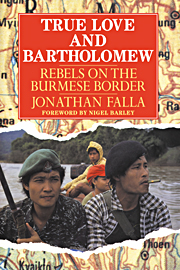Book contents
- Frontmatter
- Contents
- List of illustrations
- Foreword
- Preface
- Acknowledgments
- 1 A bronze drum
- 2 Boar Tusk's children
- 3 White collar Flowerland
- 4 True Love at home
- 5 Water child, land child
- 6 A simple man
- 7 Fighting mean, fighting clean
- 8 Great Lake and the Elephant Man
- 9 Bartholomew's boarders
- 10 The three seasons
- Interlude: from the Kok river
- 11 Last of the longhouses
- 12 A delicate bamboo tongue
- 13 True Love in love
- 14 Fermented monkey faeces
- 15 Perfect hosts
- 16 Old guard, young Turks
- 17 True Love and White Rock
- 18 Insurgents in a landscape
- 19 True Love and sudden death
- 20 Portraits
- Notes
- Bibliography
- Index
5 - Water child, land child
Published online by Cambridge University Press: 28 October 2009
- Frontmatter
- Contents
- List of illustrations
- Foreword
- Preface
- Acknowledgments
- 1 A bronze drum
- 2 Boar Tusk's children
- 3 White collar Flowerland
- 4 True Love at home
- 5 Water child, land child
- 6 A simple man
- 7 Fighting mean, fighting clean
- 8 Great Lake and the Elephant Man
- 9 Bartholomew's boarders
- 10 The three seasons
- Interlude: from the Kok river
- 11 Last of the longhouses
- 12 A delicate bamboo tongue
- 13 True Love in love
- 14 Fermented monkey faeces
- 15 Perfect hosts
- 16 Old guard, young Turks
- 17 True Love and White Rock
- 18 Insurgents in a landscape
- 19 True Love and sudden death
- 20 Portraits
- Notes
- Bibliography
- Index
Summary
‘If it come by land, weep; if by water, laugh!’
It is sometimes said that the mark of a true mariner is that he cannot swim: he knows the sea far too well to expect to elude it. On this count, the riverine Karen of Kawthoolei are naturals, since few of them can manage a decent dog-paddle. It's only city slickers like True Love who show off in the water, freestyle. It was also True Love who told me the Karen phrase meaning ‘citizen’ – Htee po kaw po, or ‘water child land child’.
On 1 November, True Love took me downstream in Edward's boat – like most of them a dugout with a single plank raising each gunwale clear of the water by eight or nine inches; the bow a small platform shaped like an old-fashioned pen nib, very solid to withstand ramming of rocks, trees, the riverbank. At the stern, there was a platform where the pilot squatted, steering by hauling on the ‘longtai’ motor, a two-stroke Rotax that shook the boat, with two metres of drive shaft trailing in the water behind it, the propeller made of cast alloy, light and friable and called ‘the boat's leaves’. In the bow, the klee koh (boat head) stood with a pole watching for rocks. Down the boat's five-metre length, were thwarts that made hard sitting after an hour or two, but kept the log-hull from collapsing and curling up like a dry leaf. Baggage was heaped on duckboards, with anything up to a dozen passengers tucked in.
- Type
- Chapter
- Information
- True Love and BartholomewRebels on the Burmese Border, pp. 65 - 81Publisher: Cambridge University PressPrint publication year: 1991



